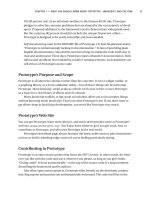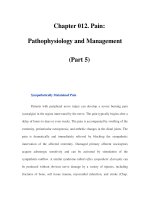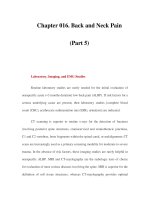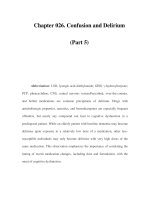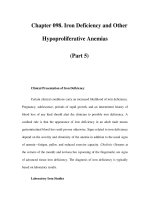Basic Electrocardiography Normal and abnormal ECG patterns - Part 5 pps
Bạn đang xem bản rút gọn của tài liệu. Xem và tải ngay bản đầy đủ của tài liệu tại đây (939.12 KB, 18 trang )
P1: OTE/SPH P2: OTE
BLUK096-Bayes de Luna June 7, 2007 21:20
66 Chapter 10
Figure 52 Scheme of a heart with a right accessory AV pathway, which leads to faster than
normal AV conduction (short PR) and early activation of part of the ventricles and appearance of
abnormal QRS morphology (delta wave) (A). All this may be observed in the first two PQRS
complexes of the scheme. The QRS is a summation complex due to initial depolarisation through
the accessory AV pathway (curved line) and the rest of depolarisation through the normal AV
pathway (discontinuous line). The third P wave is premature (atrial ectopic P
) that finds the
accessory AV pathway in the refractory period. Due to this, the impulse is only conducted by
normal AV conduction (discontinuous line in AV node) usually with a longer than normal P
R
interval, because the AV node is in a relative refractory period. This stimulus originates a normal
QRS complex (1) and, due to the fact that the accessory AV pathway is already out of the
refractory period, enters it from behind and is conducted retrogradely to the atria generating an
evident P
after the QRS complex (in the case of reciprocal intranodal taquicardia, the P
is within
the QRS complex or can be seen in its final part, modifying the QRS morphology). At the same
time, the impulse re-enters and is conducted down to the ventricles via normal AV conduction
(B-2). Due to this macroreentry circuit, the reciprocating taquicardia is maintained. The conduction
in this circuit is retrograde via accessory AV pathway (curved line) and anterograde via the normal
AV conduction (discontinuous line). The RP
ratio is smaller than the P
R ratio, which is typical of
the reciprocating taquicardia that involves an accessory AV pathway.
P1: OTE/SPH P2: OTE
BLUK096-Bayes de Luna June 7, 2007 21:20
Ventricular pre-excitation 67
Figure 53 A 50-year-old patient with the Wolff–Parkinson–White syndrome of type IV who
presents additionally a crisis of atrial fibrillation (above) and atrial flutter (below) that mimics
ventricular taquicardia. The diagnosis of atrial fibrillation is supported by the history taking (to
know that the patient presents WPW syndrome) and the following characteristics of the ECG: (1)
the wide complexes have very irregular rhythm and are more or less wider (present more or less
pre-excitation); (2) the narrow complexes (the fifth and the last one on the top) sometimes are
close, last one, and sometimes far, the fifth, to the previous QRS. In the sustained ventricular
tachycardia the QRS complexes are regular and in the case of presence of narrow complexes,
these are always close to the previous one (capture beats). Below: in the case of WPW syndrome
with flutter, the differential diagnosis with sustained ventricular tachycardia based only on ECG is
even more difficult.
Short PR type pre-excitation (Lown–Ganong–Levine
syndrome) [27] (Figure 48)
This type of pre-excitation described by Lown–Ganong and Levine is ev-
idenced by a short PR interval without changes in QRS morphology [27]
(Figure 48). Usually there is not PR segment (Figures 15 and 48). It is im-
possible to assure with a surface ECG whether it is a pre-excitation occurring
via an atrio-His path, which bypasses the AV node slow conduction area and,
therefore, does not modify the QRS complex morphology, or it is simply a
hyperconductive AV node.
The association with arrhythmias and sudden death is less frequent than in
the WPW-type pre-excitation.
Figure 54 A patient with crisis of atrial fibrillation with a very fast response of the ventricles
(> 300 x
) and sometimes very narrow RR intervals (< 200 ms). After a very short RR interval, the
crisis of ventricular fibrillation was triggered by a premature ventricular complex (arrow), which had
to be resolved by electric cardioversion.
P1: OTE/SPH P2: OTE
BLUK096-Bayes de Luna June 7, 2007 21:50
CHAPTER 11
Electrocardiographic pattern of
ischaemia, injury and necrosis
Anatomic introduction
The left ventricle has four walls (Figures 55A, B and C). Currently they are
named asfollows:septal, anterior,lateral andinferior.Classically, theterm pos-
terior wall was given to the basal part of the inferior wall that bends upwards
[31]. Now the posterior wall is named, according the statement of American
Societies of Imaging [32] and the consensus of ISHNE [33], as the inferobasal
part of the inferior wall (Figure 55). Conversely, MI of this inferobasal segment
(old posterior wall) does not explain the presence of RS in V1, which in turn is
due to infarction of the lateral wall [33–35]. The following criteria are crucial
to demonstrate it:
a The inferobasal segment depolarises after 40 ms.
b It usually does not bend up.
c The heart is located in an oblique right-to-left position not in a strict pos-
teroanterior position. Therefore, in the case of necrosis of inferobasal segment,
the necrosis vector will face V3–V4 instead of V1.
All these arguments are of crucial importance to demonstrate that the MI of
the inferobasal segment (old posterior wall) does not explain the presence of
RS in V1, which in turn is due to infarction of the lateral wall (see below and
Figure 59).
These four walls are divided into 17 segments (Figure 55A–C). Figure 56
represents these segments in the form of a bullseye and the perfusion that the
different segments receive from the coronary arteries (B–D). Nevertheless, we
should not forget that there exist some variants in coronary flow distribution
due to anatomic variants of coronaryarteries. In general, in80% of casesthe left
anterior descending (LAD) artery is long and wraps the apex, and in around
80% of cases right coronary artery (RCA) dominates left circumflex artery
(LCX) (Figure 56A).
As a consequence, the left ventricle may be divided in two zones: inferolat-
eral (which encompasses the inferior wall, the inferior part of septal wall, and
nearly all lateral wall), perfused by RCA artery and/or LCX and anterosep-
tal (which encompasses the anterior wall, the anterior part of the septal wall
and small part of mid-low lateral wall) perfused by the LAD artery (Figure
56A). The lateral wall therefore is perfused especially by LCX and often partly
by LAD and RCA. The anteroseptal zone is always perfused by LAD; how-
ever, the LAD artery usually also supplies blood to the inferior part of the
inferior wall (long LAD that wraps the apex). The RCA perfuses the inferior
68
P1: OTE/SPH P2: OTE
BLUK096-Bayes de Luna June 7, 2007 21:50
Electrocardiographic pattern of ischaemia, injury and necrosis 69
Basal
A
B
C
B
A
4
4
13
13
14
15
15
16
17
17
8
9
10
10
11
127
7
3
5
6
2
1
1
5
2
1
12
16
6
7
13 14
8
17
RV
11
16
17
14
9
RV
Y
Y
X
X
3
4
10
15
A
A
A
B
B
B
Mid
Apical
Apex
Figure 55 (A) Segments into which the left ventricle is divided, according to the transverse
sections (short axis view) performed at basal, medial and apical levels. The basal and medial
sections delineate six segments each, while the apical section shows four segments. Together
with the apex, they constitute the 17 segments into which the heart can be divided, according to
the classification of the American Imaging Societies [32]. Anterior wall corresponds to 1, 7 and 13
segments, inferior wall to 4, 10 and 15 (4 was the old normal posterior wall and now named
inferobasal segment), septal to 2, 3, 8, 9 and 14, and lateral to 5, 6, 11, 12 and 16, segment 17 is
the apex. (B and C) View of the 17 segments with the heart open on a horizontal longitudinal
plane obtained by opening the heart following the line AB of A. and oblique–sagittal (right view)
plane obtained following the line XY of B (C).
wall, predominantly the mid-inferior part of the wall and the inferior part
of the septum and, in the case of evident RCA dominance, all inferior wall
and also part of the lateral wall. The LCX supplies blood to the inferolateral
zone, especially the inferobasal part of the inferior wall and the lateral wall
by its branch called the oblique marginal (OM) artery. The areas perfused by
coronary arteries with the areas of shared perfusion are displayed in Figure 56.
Electrophysiological introduction
Myocardial ischaemia represents a decrease in the perfusion of a certain area
of the myocardium (ischaemic heart disease) generally due to atherothrom-
bosis. If significant and persistent, it usually leads to tissue necrosis (myocar-
dial infarction). Different degrees or types of clinical ischaemia correspond
to different electrocardiographic patterns. The so-called electrocardiographic
pattern of ischaemia is represented by changes in T wave, the ECG pattern
of injury by ST changes, while pathologic Q wave classically corresponds
to an ECG pattern of necrosis. In Figure 57, we can observe ionic changes,
P1: OTE/SPH P2: OTE
BLUK096-Bayes de Luna June 7, 2007 21:50
70 Chapter 11
Figure 56 (B)–(D) Perfusion of these segments by the corresponding coronary arteries can be
seen in a bullseye perspective. (A) The areas of shared perfusion. (E) The correlation with ECG
leads (see the text).
Figure 57 Observe the corresponding electrical charges and ionic changes (A and C), DTP levels
and TAP morphologies (D), clinical ECG (E), and pathological finding (F), in different types of
tissue (normal, ischaemic, injured and necrotic) (B).
P1: OTE/SPH P2: OTE
BLUK096-Bayes de Luna June 7, 2007 21:50
Electrocardiographic pattern of ischaemia, injury and necrosis 71
Table 8 Different ECG patterns in acute and chronic ischaemic heart disease and grade of
myocardial involvement.
1. STE-ACS First predominant, subendocardial compromise occurs and later, transmural and
homogeneous compromise in a heart usually without important previous ischaemia
1.1. Typical patterns
Evolving Q wave MI:
Coronary spasm (atypical STE-ACS):
1.2. Atypical patterns (see Figure 72 and Table 11)
2. Non STE-ACS Compromise sometimes extensive and even transmural, in a heart usually
with previous ischaemia
2.1. With evident and predominant subendocardial involvement (see Figure 67A and 68B)
and usually increase of LV telediastolic pressure. “Active ischaemia”. ST depression that
sometimes only appears during pain
2.2. Without predominant subendocardial involvement. Often represent a post-ischaemic
pattern (see p. 74). Flattened or negative T wave may appear (see Figure 60B and 61B and C).
Sometimes with negative U wave
3. Chronic heart disease with or without transmural involvement:
—May or may not be present pathological Q wave (see Table 14)
—Also ST deviations and flat/negative T wave may be present
—The presence of “active ischaemia” is only evident if ST/T changes occur during pain or
exercise
ACS, acute coronary syndrome.
anatomopathologic alterations and electrophysiologic characteristics that ac-
company different patterns (ECG pattern of ischaemia, injury and necrosis).
The relationship between the degree of ventricular wall involvement, degree
and type of ischaemia and electrocardiographic patterns of ischaemia, injury
and necrosis is given in Table 8.
Occlusionof anarterymay originateadirect ECG pattern inleads facing the
affected zone and also reciprocal (indirect) ECG patterns (Figures 58 and 59).
Inacute coronary syndromes (ACS) thereciprocalchanges (‘ups anddowns’of
P1: OTE/SPH P2: OTE
BLUK096-Bayes de Luna June 7, 2007 21:50
72 Chapter 11
I
I
V
1
–V
4
II, III, VF
II, III, VF
II, III, VF
Figure 58 (A) How in the case of ST-segment elevation in precordial leads, as a consequence of
LAD occlusion, the ST changes in reciprocal leads (II, III, VF) allow us to identify whether the
occlusion is in the proximal (above) or distal LAD (below). (B) How in the case of ST elevation in
inferior leads (II, III, VF) the ST changes in other leads, in this case lead I, provide information on
whether the inferoposterior infarction is due to RCA (above) or LCX (below) occlusion (see the
text).
ST – explained by the ST injury vector theory) (see Figure 58) are important for
predicting which is the culprit artery (RCA vs LCX) in the case of ST elevation
in II, III, VF (Figure 58A), and where the place of occlusion in LAD in the
case of ST elevation in precordial leads (Figure 58B). Similarly, in the chronic
phase we are able to evaluate tall R and positive T waves in V1–V2 as a mirror
image of infarction affecting the lateral wall and not the posterior wall as was
thought previously (Figure 59) according to the necrosis vector theory and the
correlation withcardiovascular magnetic resonance(CMR) [33–35](see p. 104).
Henceforth, we will commenton the characteristics of the ECG pattern of is-
chaemia, injury and necrosis observed (see Table 8 and Figure 57) witha grad-
ually decreasing coronary blood flow leading finally to cell death. It must be
remembered that a similar ECG pattern may be observed in various clinical
Figure 59 (A) The correlation with CMR has demonstrated that in the case of infarction of
inferobasal segment of the heart (old posterior wall) the infarction vector faces V3 instead of V1,
and therefore does not generate RS morphology in V1. On the contrary, (B) in the case of lateral
infarction, the infarction vector faces V1 and may generate RS in V1 (see Figures 94 and 95).
P1: OTE/SPH P2: OTE
BLUK096-Bayes de Luna June 7, 2007 21:50
Electrocardiographic pattern of ischaemia, injury and necrosis 73
situations apart from coronary artery disease. Therefore, in the case of an
isolated electrocardiogram with a pattern suggestive of ischaemia, injury or
necrosis, it is always mandatory to perform exhaustive differential diagnosis
(Tables 9–12 and 16).
Electrocardiographic pattern of ischaemia
The ECG pattern of ischaemia (changes of T wave) is recorded in an area
of myocardium in which a delay of repolarisation occurs (Figure 57(2)) as a
consequence of decrease in blood perfusion of smaller degree than what is
necessary to develop an injury pattern, or the pattern is a consequence of
ischaemia but not due to “active ischaemia’’ (post ischaemic changes).
Fromthe experimentalpointofview,ischaemiamay besubepicardial,suben-
docardial or transmural. From the clinical point of view only subendocardial
and transmural ischaemia exist and the latter is considered to be equivalent
to subepicardial owing to its proximity to the explorer electrode.
Experimentally, the ECG pattern of ischaemia (changes in T wave)maybe
recorded in an area of the left ventricle subendocardium or subepicardium in
which, as a consequence of a decrease in blood supply (less than needed to
generate the ECG pattern of injury) or for other reasons such as cooling the
area, a delay in repolarisation in the affected zone occurs.Iftheischaemia is
subendocardial a higher than normal positive T wave is recorded and in the
case of subepicardial ischaemia (or in clinical practice transmural due to its
proximity to the explorer electrode) a flattened or negative T wave.
A vector is originated from the zone that as a consequence of ischaemia is
not yet fully repolarised and still presents negative charges, and is directed
towards the already repolarised area presenting with positive charges (vector
of ischaemia). In the case of subendocardial ischaemia the vector of ischaemia
moves away from the ischaemic zone with late repolarization and originates a
taller than normal T wave (Figure 60A). If the zone with late repolarization is
subepicardial (or in clinical practice transmural), the vector of ischaemia will
explain flattened or negative T wave (Figure 60B).
The second way to explain the electrocardiographic pattern of ischaemia is
based on the fact that the ECG curve is a consequence of the sumoftheTAPof
the part of a left ventricle distal to an electrode (subendocardial zone) and
the part proximal to electrode (subepicardial zone). Figure 61 shows how
in the case of delay of TAP formation in the subepicardial zone (C and D)
the sum of both TAPs explains the formation of flattened or negative T wave
(electrocardiographic pattern of subepicardial ischaemia) and in the case of
subendocardial ischaemia the delay of TAP in subendocardium will prolong
TAP in this zone and the sum of both TAPs explains why the T wave presents
higher voltage (B) (electrocardiographic pattern of subendocardial ischaemia).
The T-wave changes, named ECG patterns of ischaemia, are recorded in the
second part of repolarisation usually without any evident involvement of the
first part of repolarisation (ST segment). This is due to the fact that this pattern
appears as a consequence of lengthening of the TAP without changes in the
P1: OTE/SPH P2: OTE
BLUK096-Bayes de Luna June 7, 2007 21:50
74 Chapter 11
Figure 60 (A) Subendocardial ischaemia. Subepicardial repolarisation is complete, but the TAP in
the subendocardium is longer than normal (TAP prolongation further beyond the dotted line) since
the subendocardium is not completely repolarised. Thus, the vector head that is generated
between the already polarised area in the subepicardium with positive charges and the
subendocardial area still with incomplete repolarisation with negative charges due to the ischaemia
in that area, named ischaemic vector, is directed from the subendocardium to the subepicardium,
even though the direction of the repolarisation phenomenon goes away from it because the
direction of the phenomenon (
) goes from the less ischaemic area to the more ischaemic
area. Therefore, the subepicardium faces the vector head (positive charge of the dipole), which
explains why the T wave is more positive than normal. In subepicardial ischaemia a similar but
inverse phenomenon (B) occurs, which explains the development of flattened or negative T waves.
end of depolarisation and first part of repolarisation (ST segment). As a con-
sequence, usually the T wave of ischaemia follows an isoelectric ST segment.
Alterations of the T wave due to ischaemic heart disease (Table 8)
Negative T wave, known as ECG pattern of subepicardial ischaemia (clini-
cally transmural), secondary to ischaemic heart disease is symmetric and not
too wide, with usually an isoelectric ST segment. It is a common finding, es-
pecially in a chronic Q-wave-type post-infarction phase, and is a manifestation
P1: OTE/SPH P2: OTE
BLUK096-Bayes de Luna June 7, 2007 21:50
Electrocardiographic pattern of ischaemia, injury and necrosis 75
Figure 61 Explanation of how the sum of the transmembrane action potential (TAP) from the
subepicardium and the subendocardium explains the ECG, both in the normal situation (A) , as in
the case of subendocardial ischaemia (tall and peaked T wave) (B), and also in mild to severe
subepicardial ischaemia (flattened or negative T waves) (C and D). This is due to the fact that the
ischaemic area (subendocardium in B and subepicardium in C and D) shows a delay in
repolarisation and, consequently, a more prolonged TAP (see the text).
of an ACS, both STE-ACS and non- STE-ACS, (Tables 8 and 11, and Figure 72).
In thecase of post-myocardialinfarction patients,the ECG patternof ischaemia
(negative T wave) is due more to changes of repolarisation induced by Q-wave
necrosis than to clinically active ischaemia. In ACS the negative T wave is a
consequence of ischaemia but not due to “active’’ ischaemia. Especially when
deep negative T wave is present in VI–V4, it may be the expression of critical
LAD occlusion but with still-opened artery or great collateral circulation, (Fig-
ure 72C and Table 11A) or it is the expression of reperfusion after fibrinolysisi
or PCI. Both cases may evolve to STE-ACS. The presence of negative, usually
non-deep, T wave in non-STE-ACS is relatively frequent and probably is not
due to “active ischaemia’’ but is a consequence of it (changes after ischaemia)
(Table 11B).
An electrocardiographic pattern of ischaemia is observed in different leads
according to anaffectedzone. In the case of inferolateral involvement,T-wave
changes are observed in II, III, VF (inferior wall) and/or V1–V2 (mirror image
of inferolateral involvement) as positive instead of negative due to the mirror
image (Figure 59). In subepicardial inferobasal injury, ST depression will be
recorded instead ofST elevation, and in thecase of lateral necrosis a tall R wave
is recorded instead of Q wave (see below). As we have already commented,
we have demonstrated [34,35] that the RS in V1 is due to lateral necrosis and
not inferobasal necrosis (Figures 59 and 62). In anteroseptal involvement,
T-wave changes are found from V1–V2 to V4–V6, and, if mid anterior wall
and mid anterior portion of the lateral wall are involved (occlusion proximal
to first diagonal), also in V6, I and VL (Figure 63). Also, the involvement of
lateral wall areas perfused by LCX may generate not only positive T wave in
P1: OTE/SPH P2: OTE
BLUK096-Bayes de Luna June 7, 2007 21:50
76 Chapter 11
I II III VR VFVL
V
1
V
2
V
3
V
4
V
6
V
5
Figure 62 A 55-year-old man with inferolateral infarction according the new classification (Table
15). The T wave in V1–V3, which are tall and peaked, is not the result of anterior subendocardial
ischaemia, but of inferolateral subepicardial ischaemia. See also typical Q wave in II–III–AVF and
RS in V1 with Rs in V2–V3 seen in this type of infarction (see Figure 58).
V1–V2, but also negative T wave in leads V6, I, VL, and in the chronic phase
of infarction, the RS pattern in V1–V2, and/or a “qr’’ or low “r’’ may be seen
in I, VL, V5–V6, but “QS’’ in VL. This morphology (QS in VL without Q in
V5–V6) is recorded in the case of isolated infarction of the mid anterior wall
and mid lateral wall that is due to the first diagonal (D1) occlusion (Figure 64).
This pattern is never seen in the case of necrosis of a high lateral wall that is
perfused by LCX.
In contrast, the T wave of subendocardial ischaemia is generated during
the early phase of ischaemia when predominantly the subendocardial area
is involved (Table 8(1)). It is difficult to diagnose owing to its transient charac-
teristics and the difficulties in distinguishing from a normal positive T wave.
Therefore requential changes should be evaluated (Figure 65). It is observed
in the initial phase of Prinzmetal’s angina crisis (coronary spasm) (Table 8(1)
and Figure 65) and occasionally in the hyperacute phase of ACS (Figure 72B).
Figure 63 (A) 60-year-old patient with anterior extensive infarction according the new
classification (Table 15). Observe in the frontal plane lateral subepicardial ischaemia (negative T
waves in I and VL) with a mirror image in II, III, VF and in the HP, the anterolateral subepicardial
ischaemia (negative T waves from V1 to V6 and ± V1–V2, and Q waves from V1 to V4 and VL )
and low voltage of R in V5–V6 and I.
P1: OTE/SPH P2: OTE
BLUK096-Bayes de Luna June 7, 2007 21:50
Electrocardiographic pattern of ischaemia, injury and necrosis 77
Figure 64 A 67-year-old man with mid-anterior infarction according the new classification (Table
15). (A) Acute phase ST elevation in I, VL and some precordial leads and ST depression in II, III,
VF (III > II). (B) Chronic phase: small ‘qs’ pattern in VL without abnormal Q wave in V5–V6.
Figure 65 Patient with Prinzmetal’s angina crisis. From left to right: four sequences recorded
during a crisis of 4-minutes with the Holter recording. Observe how the T wave becomes peaked
(subendocardial ischaemia), with a subepicardial injury morphology appearing later, and at the
end of the crisis, presenting again a subendocardial ischaemia morphology before the basal
ECG returns.
P1: OTE/SPH P2: OTE
BLUK096-Bayes de Luna June 7, 2007 21:50
78 Chapter 11
Table 9 Causes of a more positive than normal T wave (apart from ischaemic heart disease) (see
Figure 66).
1 Normal variant: vagotonia, sportsmen, the elderly, etc.
2 Acute pericarditis
3 Alcoholism
4 Hyperkalaemia
5 Moderate left ventricular hypertrophy in heart diseases with diastolic overload (e.g. aortic regur-
gitation)
6 Stroke
7 In advanced AV block (tall and peaked T wave in the narrow QRS complex escape rhythm)
8 In V1–V2 as a ‘mirror’ image of inferolateral subepicardial ischaemia or secondary to left ventric-
ular hypertrophy
Alterations in T wave in various conditions other than ischaemic
heart disease
The most frequent causes, apart from ischaemic heart disease of a negative,
flattened or more-positive-than-normal T wave, are summarised in Tables 9
and 10. Pericarditis is a very important differential diagnosis of the pattern
of subepicardial ischaemia. Apart from clinical characteristics of precordial
pain, the ECG in pericarditis shows a pattern of more extensive subepicardial
ischaemia with less frequent mirror patterns in the frontal plane, and gen-
erally the negativity of T wave is smaller. The examples of different T-wave
abnormalities not due to ischaemic heart disease may be observed in Figure 66.
Table 10 Causes of negative or flattened T waves (apart from ischaemic heart disease) (see
Figure 60).
1 Normal variants. Children, Black people, hyperventilation and women (right precordial leads,
etc.); may sometimes be diffuse (global T-wave inversion of an unknown origin). Frequently occurs
in women.
2 Pericarditis. In this condition, the image is usually extensive, but generally with not such signifi-
cant negativity.
3 Cor pulmonale and pulmonary embolism.
4 Myocarditis and cardiomyopathies.
5 Mitral valve prolapse. Not always; if it appears, it does so particularly in II, III and VF and/or V5
and V6.
6 Alcoholism.
7 Strokes. Relatively infrequent.
8 Myxoedema. Usually flat T wave or only slightly negative.
9 Sportsmen. With or without ST-segment elevation. Hypertrophic cardiomyopathy, especially api-
cal type, must be ruled out.
10 After the administration of certain drugs (prenylamine, amiodarone) (flattened T wave).
11 In hypokalaemia the T wave can flatten.
12 Post-tachycardia.
13 Abnormalities secondary to left ventricular hypertrophy or to left bundle branch block.
14 Intermittent left bundle branch block and other situations of intermittent abnormal activation
(pacemakers, Wolff–Parkinson–White syndrome) ‘electrical memory’.
P1: OTE/SPH P2: OTE
BLUK096-Bayes de Luna June 7, 2007 21:50
Electrocardiographic pattern of ischaemia, injury and necrosis 79
Figure 66 T-wave morphologies in conditions other than from ischaemic heart disease. (1) Some
morphologies of flattened or negative T wave: (A and B) V1 and V2 of a healthy 1-year-old girl; (C
and D) alcoholic cardiomyopathy; (E) myxoedema; (F) negative T wave after paroxysmal
tachycardia in a patient with initial phase of cardiomyopathy; (G) bimodal T with long QT frequently
seen after long-term amiodarone administration; (H) negative T wave with a very wide base,
sometimes observed in stroke; (I) negative T wave preceded by ST elevation in an apparently
healthy tennis player; (J) very negative T wave in the case of apical cardiomyopathy; (K) negative
T wave in the case of intermittent LBBB in a patient with no apparent heart disease. (2) Tall
peaked T wave in the case of (A) variant of normality (vagotonia with early repolarisation), (B)
alcoholism, (C) left ventricular enlargement, (D) stroke and (E) hyperkalemia.
P1: OTE/SPH P2: OTE
BLUK096-Bayes de Luna June 7, 2007 21:50
80 Chapter 11
Electrocardiographic pattern of injury
The pattern of injury (changes in ST) is recorded in an area of the my-
ocardium in which an evident diastolic depolarisation occurs as a conse-
quence of a significant decrease in blood supply (clinically “active’’ ischaemia
more significant than that needed to generate the electrocardiographic pat-
tern of ischaemia) (Figure 57(3)). If the diastolic depolarisation is transmural
its electrocardiographic expression, due to the proximity of the electrodes
to the subepicardium, is subepicardial injury. The zone with diastolic de-
polarisation according to the membrane response curve forms a transmem-
brane action potential with slow ascent and lower area (so-called low-quality
TAP). The changes originated by this diastolic depolarisation in the baseline
(TQ space) are compensated by automatic AC couplet amplifiers in ECG de-
vices and are recorded, due to the presence of ‘low-quality’ in some TAP,
as changes in ST segment (‘ups and downs’ of ST). If the ischaemia is very
severe and acute, changes will also affect the last part of QRS. In the leads
facing the injured zone, if the current of injury predominates in the suben-
docardium ST-segment depression will be recorded and if in the subepi-
cardium (clinically transmural) an ST-segment elevation will be observed.
Mirror patterns also exist, for example, if the subepicardial injury exist in the
lateral-inferobasal wall, ST-segment elevation will be observed in the leads
on the back while ST-segment depression will be seen in V1–V3 as a mirror
image.
The ST-segment changes may be explained by two theories: vector of in-
jury or as a consequence of the sum of TAPs of the two parts of the left ven-
tricle subendocardium plus subepicardium. According to the theory of vec-
tor of injury, in the case of injury predominantly in the subendocardial zone
at the end of depolarisation (beginning of systole) the injured zone presents
less negative charges (Figure 67A) and, consequently, a current flow exists
from the zone with more negative charges (less injured zone) to less nega-
tive charges (more injured zone). This originates an injury vector. This vector
has relatively positive charges (less negative) in the head. Therefore, in cases
of subendocardial injury, both in experimental (Figure 67A(1)) and clinical
state (Figure 67A(2)), in which case the injury is not exclusively but predom-
inantly in the subendocardium, a depression of ST will be recorded. In the
case of subepicardial experimental injury (Figure 67B(1)) and clinically trans-
mural injury (Figure 61B(2)) an ST elevation will be seen (see the caption).
Figure 68 explains how the theory of the sum of the TAP of subendocardium
and subepicardium may explain the presence of ST-segment depression in
subendocardial injury or ST-segment elevation in the case of subepicardial
(clinically transmural) injury (see the caption).
Figure 69 shows different morphologies of subepicardial injury during the
evolution of acute Q-wave anterior myocardial infarction. Figure 70 shows
subendocardial injury pattern observed in course of an acute non-Q-wave
myocardial infarction.
P1: OTE/SPH P2: OTE
BLUK096-Bayes de Luna June 7, 2007 21:50
Electrocardiographic pattern of ischaemia, injury and necrosis 81
Figure 67 (A) In significant experimental subendocardial injury (1) (injured zone) the injury vector
is directed from the non-injured zone (with more negative electric charges) towards the injured
zone (with fewer electric charges). The injury vector faces the injured zone, while the ischaemia
and necrosis vectors are directed away from the involved area. Therefore, when experimental
significant ischaemia (injury) is located in the subendocardium (A-1), the vector is directed from
the subepicardium to the subendocardium and generates ST-segment depression in the ECG
leads opposing the mentioned zone. In clinical subendocardial injury this is predominantly but not
exclusively subendocardial (A-2). (B) In the case of significant experimental subepicardial
ischaemia (injured zone), (B-1) the injury vector is directed towards the subepicardium because, in
this case, the current flow runs from the subendocardium to subepicardium and generates
ST-segment elevation in the precordial ECG leads opposing the mentioned zone. In clinical
practice, exclusive subepicardial ischaemia does not exist. The ischaemia that at first is
subendocardial, soon becomes transmural. In this case, the surface ECG records the pattern as if
it is only subepicardial, due to proximity of the recording electrode to the subepicardium.
Acute coronary syndromes: value of electrocardiographic pattern
in classification of acute coronary syndromes, artery occlusion
location and risk stratification [36–42]
In around 10–20% of cases of ACS there are confounding factors (left ventricle
hypertrophy, bundle-branch block, pacemaker, WPW) that make it more dif-
ficult to ascertain the primary change of repolarization induced by ischaemia
in ACS [39, 57].
Acute coronary syndromes (ACS) with narrow QRS and without confound-
ing factors, may be classified into two types according to their electrocar-
diographic expression: with ST-segment elevation (STE-ACS) or without
P1: OTE/SPH P2: OTE
BLUK096-Bayes de Luna June 7, 2007 21:50
82 Chapter 11
Figure 68 Both the subendocardial (ST depression) and the subepicardial injury (ST elevation)
pattern may be explained by the sum of the subendocardial and subepicardial TAPs. The injured
zone, subendocardium in (B) and subepicardium in (C), due to the presence of diastolic
depolarisation produces a TAP that is slow rising and of less area (‘low-quality TAP’). This explains
the ECG morphology; ST elevation in subepicardial injury (C) and ST depression in
subendocardial injury (B). Clinically, in the case of subepicardial injury pattern the injured zone is
transmural but an ST elevation is recorded because the exploring electrode is close to the
subepicardium.
ACDB
V
3
V
3
V
3
V
3
Figure 69 A 72-year-old patient with an extensive anterior infarction. Note the evolutionary
patterns: (A) 30 minutes after the onset of pain; (B) 3 hours later; (C) 3 days later; (D) 3 weeks
later.
P1: OTE/SPH P2: OTE
BLUK096-Bayes de Luna June 7, 2007 21:50
Electrocardiographic pattern of ischaemia, injury and necrosis 83
Figure 70 A 65-year-old patient with non-Q-wave infarction. Note the evolutionary patterns from
(A) to (D) during the first week until the normalisation of the ST segment.
ST-segment elevation (NSTE-ACS). This classification has a clear clinical sig-
nificance as the former are treated with fibrinolysis and the latter are not.
Figure 71 showsthe ECG presentation inACS and itsevolution. Table 11 shows
the different ECG patterns seen in the two types of ACS (see below). Very of-
ten both ST depression and ST elevation coincide with or without changes of
T wave. However, we consider patterns of STE-ACS where the morphology
of ST elevation is the predominant and patterns of non STE-ACS where the
predominant is the morphology of ST depression. However, the STE-ACS may
present some atypical patterns (see Figure 72), and in non STE-ACS include
cases of ST segment depression and flat or negative T wave, and even of nor-
mal ECG. As a matter of fact, 10–15% of ACS present a normal ECG pattern
without pain and even in rare cases the ECG remains normal or nearly normal
during the evolution of STE-ACS (grade 1 of ischaemia, p. 92). Sometimes the
very subtle ECG changes are transient and appear in the hyperacute phase
(pseudonormal ECG pattern) (see Figure 72B).
Acute coronary syndrome with ST-segment elevation: ST-segment
elevation acute coronary syndrome (STE-ACS)
Sometimes a small ST-segment elevation but with a convex slope to the iso-
electric line may be seen as a normal variant in V1–V2 (Figure 22B). However,
new occurrence of ST elevation over 2 mm in V1–V3 leads and over 1 mm
in other leads is considered abnormal and evidence of acute coronary is-
chaemia in the clinical setting of ACS. There are the cases of STE-ACS which,
thanks to moderntreatment, donot leadtoQ-wave infarction(in whichcase we
speak about non-Q-wave infarction) and even may not provoke an increase
in enzymes and result in aborted infarcts
∗
(unstable angina). Nevertheless,
the majority of them will develop a myocardial infarction, usually of Q-wave
type (Figure 71).
∗
Due to that we prefer to speak of STE-ACS than STEMI (myocardial infarction). However,
both terms may be used independently.


